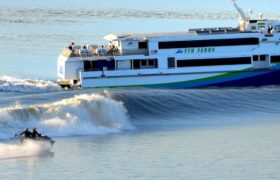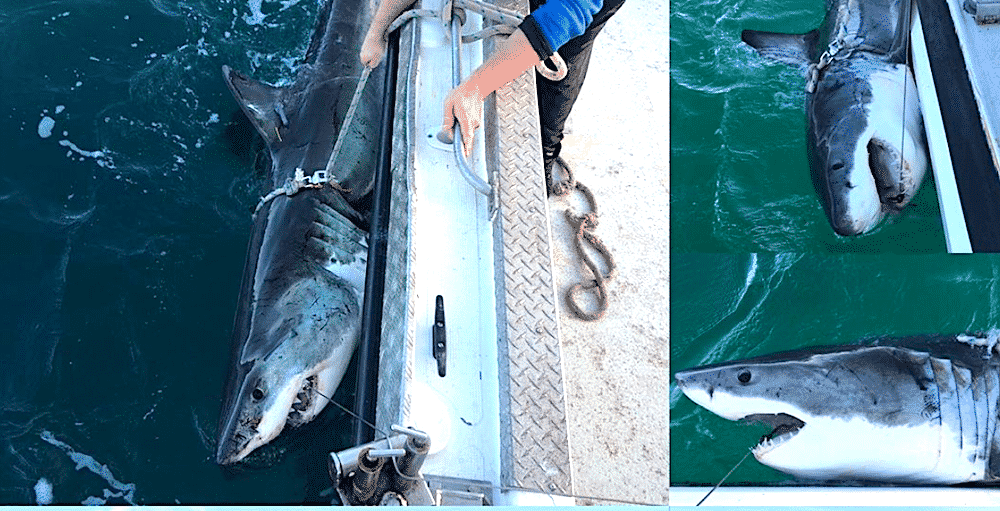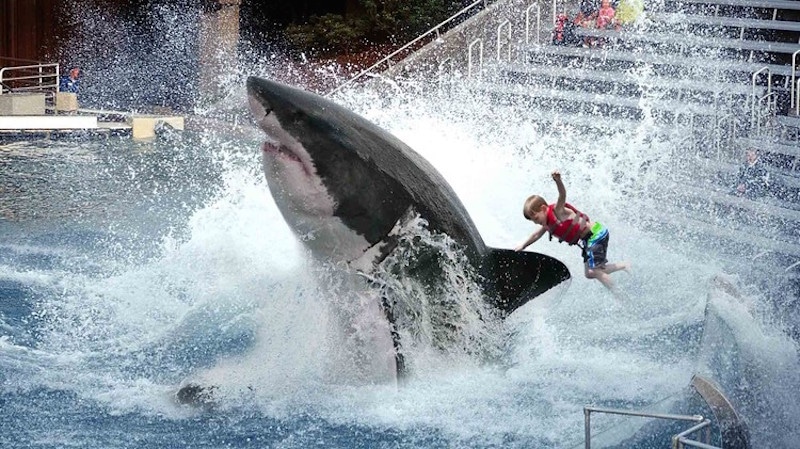"Most reasonable people would agree that the only
way to significantly reduce the rate of shark attacks is by killing
the most dangerous sharks."
There is talk of a promising new solution to Australia’s
Great White crisis.
Using technology developed for commercial fishing, standard drum
lines would target the most aggressive sharks, by surrounding the
bait with an electric field that deters less aggressive sharks.
Each species of ‘dangerous’ shark includes many individuals that
are probably not all that dangerous. This might explain the
occasional video of a placid ‘man-eater’ swimming perilously close
to surfers.
It might also explain the statistical insignificance of shark
attacks compared to other public health risks. After all, the
number of sharks biting people cannot exceed the number of shark
attack victims.
Clearly, most ‘man-eaters’ are not interested in attacking
people.
So, the problem is not the species of shark, but the few
aberrant individuals that give the species a bad name.
French shark scientist, Eric Clua suggests that; “Selective
removal of problem individuals following shark bite incidents would
be consistent with current management practices for terrestrial
predators, and would be more effective and more environmentally
responsible than current mass-culling programs.”
But, why not get rid of the problem individuals before they
attack?
Besides, the complete removal of dangerous individuals would
have the glorious effect of altering the gene pool and thus taming
the species forever. Then, all the shark nets could be removed, to
allow whales, dolphins and sea turtles to travel freely, without
getting tangled in a net and drowning.
Some environmentalists will abhor the new method of preventing
shark attacks, because they impulsively dismiss any attempt to
control nature. But, they will disguise their hatred of humanity,
with a plausible explanation for how the ecosystem depends on these
few ‘alpha-predators’ to stabilise the ecosystem; like claiming
that the occasional shark attack is a small price to pay for
controlling the population of the Humboldt squid, a potentially
more terrifying creature.
One way or another, humans will be sacrificed for nothing but
the symbolic value of giving nature free rein. Our predicament is a
potent element of their belief system.
In the meantime, we need to address the problem of shark
attacks.
Luckily, there is a solution, and it is a surprisingly simple
one. The problem is that politics nowadays is governed by emotional
outbursts. As a result, we suffer from an overly emotional
attachment to nature. This seems appropriate to the Western mind
nurtured on a religious diet of environmentalism.
But, compassion is, first and foremost, an emotion felt for
people. It is an abomination to value nature at the expense of
humanity.
It can be frustrating when people nonchalantly disregard the
horror, with flippant remarks that essentially blame victims for
being attacked.
But, it is hardly worth worrying about.
People generally don’t think things through. It is the easy
answer to a contentious issue. What is worrying, is when people in
positions of authority, who are paid to serve the public on this
very issue, fail to appreciate the gravity of the situation.
New South Wales’ Department of Primary Industries (DPI) refuses
to accept the many flaws in their approach, having just received
eight-million dollars to continue a program that offers next to no
benefit to the surfing community.
They claim, for example, that tagging sharks helps to reduce the
risk of attack, because sharks tend to avoid the coast for many
weeks after the traumatic experience of being tagged.
On the face of it, this seems like a reasonable assumption,
until you realise how unlikely it would have been for any of these
sharks to have attacked someone, had they not been diverted out to
sea. The temporary removal of an occasional shark is hardly worth
mentioning.
I am not against tagging for sake of research.
Ultimately, I think the program could help to reduce the rate of
shark attacks.
But, we would need many more listening stations, maybe ten times
as many. However, the purpose of the listening stations should not
be to inform the public every time a shark has been detected. The
odd shark swimming within range of a listening station just isn’t
noteworthy.
What the public needs to know is if the rate of shark detections
has increased to a level that indicates a possible trend and thus
greater risk of shark attack.
Dr Moltschaniwskyj explained that the rationale is moreso to
remind the public that sharks are part of the ocean. So, we agree
that the actual presence of the shark does not represent an
imminent threat to be avoided.
Even in the Lennox to Ballina stretch, where we have the highest
concentration of listening stations, these random detections would
be a small fraction of the number of sharks in similar proximity to
surfers at any time. My guess is that most surfers don’t bother
with the service, since most of the sharks passing through the area
go undetected.
If that is true, then the alerts only serve to torment people
who rarely enter the water anyway, including mothers who worry
about their kids every time a shark detection gets circulated on
the net.
The new drone technology is impressive. But, it will only ever
be deployed at a small fraction of surf spots, and for a small
fraction of the time people surf. So, I do not believe that drones
will reduce the rate of shark attacks.
Our most recent fatality, fifteen-year-old
Mani Hart-Deville, was surfing at a remote
location that is probably too remote to justify the funding of
drone surveillance. There is also the problem of murky water
affecting visibility.
But, on those classic
crystal clear days, it is probably appreciated by parents taking
their kids to the beach.
I suggested to Dr Moltschaniwskyj that the DPI might consider
surveying the surfing community to find out how many people were
actually using the service that notifies users whenever a shark has
been detected.
I thought I was talking their language. But, there was no
response.
I don’t blame her; because, in some sense, not replying speaks
volumes. I probably wouldn’t reply either, if my livelihood
depended on toeing the line.
Who knows what people really think these days. We are all hemmed
in, one way or another. I have copped a lot of flak for speaking
up. So, I generally avoid the topic. But, it is very concerning
that two reasonable people are unable to communicate freely about
such a significant public concern.
Apart from drawing attention to possible limitations in their
approach, I also suggested that they focus on developing a model
that predicts the risk of encountering a shark. It is not good
enough to randomly remind surfers that sharks are a potential
menace. All this does is transfer responsibility to the eventual
victims: “I told you there were sharks out there!”
Besides, surfable conditions are rare. The surfing lifestyle
requires taking advantage of every opportunity. So, the perceived
risk only becomes relevant for a few sorry weeks after an
attack.
One attack makes you wary.
Two attacks make you nervous.
It’s not very sophisticated.
A scientifically informed model would assess the risk, based on
environmental factors, like ocean temperature, rainfall, proximity
to river mouths, whale migration, time of day, and trends in tagged
shark movements. Shark scientists have alluded to the potential for
such a formula.
Ideally, all known risk factors would be condensed into a simple
format that could be read at a glance: i.e. Low, Medium, High, etc.
Although costly, physical signage would be more effective than an
app, despite the apparent convenience of smartphones. You can’t
expect everyone to be fastidious in their monitoring of the shark
situation.
I think most reasonable people would agree that the only way to
significantly reduce the rate of shark attacks is by killing the
most dangerous sharks. Theoretically, this could be achieved with
almost clinical precision using an extensive array of electrified
drum lines targeting only the most aggressive individuals.
Policy makers can fret over how many sharks the electorate will
tolerate being dispatched each year. But, at least they can report
with some confidence that the screening process is stringent:
sensitive sharks will be turned away.
Eventually, these desperately sad tragedies could become a
distant memory.
To be honest, I have no evidence of this technology being taken
seriously. For all I know, DPI has scoffed at the suggestion.
It is loosely based on technology designed to protect baited
hooks from sharks. So, it might not be patentable.
But, I have applied for a patent, just in case.
The opportunity is lost, once it goes public.
After submitting the application, I wrote to the Minister
responsible for DPI’s operations, asking that he present it to DPI
on my behalf.
But, I am afraid he is also having difficulty penetrating DPI’s
fortress mentality.
(In 2016, Dan Webber watched as surfer Cooper Allan got
what is described on the north coast as a “Ballina hickey” from a
Great White. “I was standing in waist deep water,
about five metres away, when I saw a shark in the face of a wave
between me and three guys sitting further out,” said Dan. “A few
seconds later, I heard a shout, followed by the nose of a board
sailing through the air.” He is the author of When Great Whites Take
Over Your Beach and Sobering: The (Real) Odds of a Shark
Attack.)









